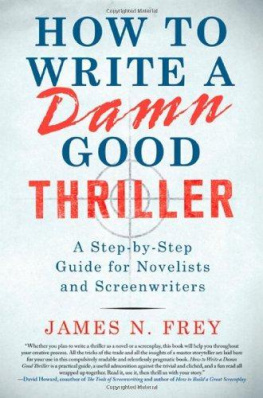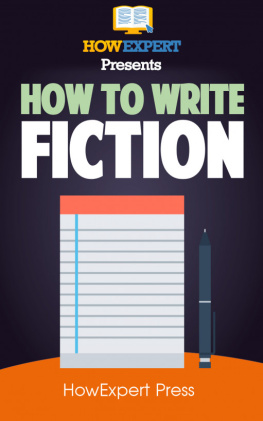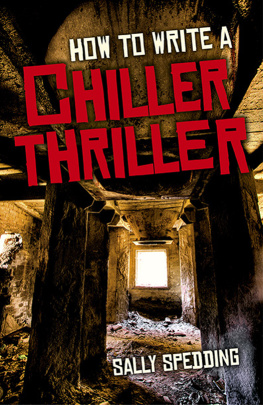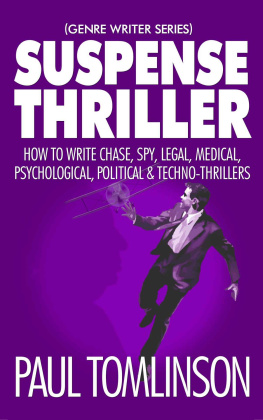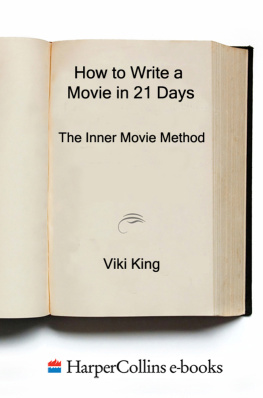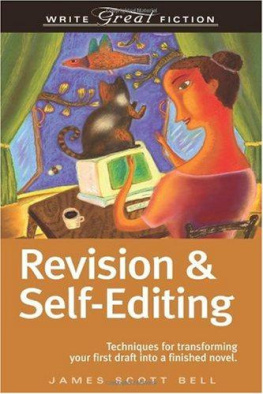
Introduction
T he aim of this book is to help you design a damn good thriller.
Thrillers are the most exciting of all the genres. Unlike writing, say, a literary tome full of angst and ennui that will sour your own stomach, let alone your reader's, writing a thriller is like riding a bobsled down Mount Everest. You can let your imagination run. You can make up wild and crazy characters and stuff them into woodchoppers. You can blow up cities. Lop heads off. Sink ships. Go to Mars.
In the world of thriller writing, anything goesas long as you thrill your audience.
The first thing you need to know about writing thrillers is that it is not brain surgery. In fact, it's easy. That's right, easy as smacking a beached banana fish. You create the characters; the characters create a thrilling story. What could be easier?
I knowyou're saying, Come on, even if it's fun, there still are sometimes big old speed bumps in the creative road. Didn't Hemingway say that to write fiction you had to go into your room every day and stare at a blank piece of paper until blood came out of your forehead?
Well, okay, there are those days. But most days, it's a hoot. No kidding.
What's a Thriller?
Before we begin, we'll need to settle on just what a thriller is.
There are all sorts of definitions for "thriller" floating around. The American Heritage Dictionary of the English Language defines a thriller as a work of fiction "that thrills, especially a sensational or suspenseful book, story, play, or movie."
That's okay, but to say a thriller thrills is not all that useful as definitions go. In fact, you might say it's circular, and as any good semanticist will tell you, a circular definition isn't worth spittle on your shoe.
Thrillers are most often described as "fast-paced" and thriller-type characters as "being in danger at every turn." Some say thrillers need to have "the thrill of the chase" or "gamesmanship." According to International Thriller Writers (their Web site: www.thrillerwriters.org), a thriller is characterized by "the sudden rush of emotions, the excitement, sense of suspense, apprehension, and exhilaration that drive the narrative, sometimes subtly with peaks and lulls, sometimes at a constant, breakneck pace. Thriller is a genre of fiction in which tough, resourceful, but essentially ordinary heroes are pitted against villains determined to destroy them, their country, or the stability of the free world. Part of the allure of thrillers comes from not only what their stories are about, but also how they are told. High stakes, nonstop action, plot twists that both surprise and excite, settings that are both vibrant and exotic, and .an intense pace that never lets up until the adrenaline-packed climax."
This seems to be an excellent description of an international thriller, even though it is my firm belief that heroes should never be ordinary; they're far more clever than ordinary or they wouldn't be worth our interest. At first they may seem ordinary, but they'll be revealed as exceptional as the story unfolds.
Okay, the main ingredient of a thriller is pulse-pounding suspense. Nearly everyone, even a highbrow New York Times critic, would agree to that. Suspense is that quality of fiction that makes the reader want to turn the pages to see what's going to happen next.
A reader of any kind of fiction might want to turn the pages to see if,
say, the hero is going to find love or happiness or come to terms with his feelings of guilt or remorse because he disappointed his parents by choosing to be an orthodontist. But this is clearly not the type of suspense we find in a thriller. In a thriller, the nature of the suspense is more intensely dramatic. A thriller is about characters who are, as Dean Koontz puts it in How to Write Best-Selling Fiction (1981), in "terrible trouble."
Terrible trouble may involve the fate of the world, or the fate of a city, or the fate of a dozen people stuck in a tram car suspended over the Grand Canyon whose cable is coming unraveled. Terrible trouble may even involve the fate of just one person. Jack London's wonderful short story "To Build a Fire" (1908) is a damn good thriller, and the stakes are but one man's life. The same is true for Alfred Hitchcock's gripping film Strangers on a Train (1951), from the novel by Patricia High-smith (1950).
The type of terrible trouble will determine the subgenre of thriller: sci-fi, horror, political, techno, man-against-nature, fantasy, supernatural, western, medical, action/adventure, military, romantic, and so on. In Great Britain and elsewhere in the English-speaking world, by the way, the word thriller is sometimes used for any kind of suspense fiction, including mystery. In the United States, mysteries are not considered to be thrillers, though they share some common elements. So what's the difference? you ask. Putting it simply:
In a mystery, the hero has a mission to find a killer.
In a thriller, the hero has a mission to foil evil.
I discussed what's required of a mystery and how to create one at length in How to Write a Damn Good Mystery (2004).
Okay now, a thriller is a story of a hero who has a mission to foil evil. Not just a heroa clever hero. Not just a missionan "impossible" mission. An "impossible" mission that will put our hero into terrible trouble. Some examples:
In Frederick Forsyth's The Day of the Jackal (1971, film 1973), the clever hero has an "impossible" mission to foil evilthe assassination of French president Charles de Gaulle.
In Gran Torino (film 2008), the clever hero has an "impossible" mission to foil evila vicious street gang that is menacing the neighborhood.
In Thomas Harris's Black Sunday (1975, film 1977), the clever hero has an "impossible" mission to foil evilthe killing of thousands of people at the Super Bowl.
In Miss Congeniality (film 2000), the clever hero has an "impossible" mission (particularly after the boss leaves her to fend for herself) to foil evilthe bombing of a beauty contest.
In The Hand That Rocks the Cradle (film 1992), the clever hero has an "impossible" mission to foil the evil that is mysteriously menacing her family.
In William Peter Blatty's The Exorcist (1971, film 1973), the clever hero has an "impossible" mission to foil evilSatan himself, who has possessed an innocent little girl.
In Fargo (film 1996), the clever hero has an "impossible" mission to foil evilthe kidnappers of an innocent housewife. In this darkly comic story, the hero fails to rescue the victim, though she succeeds in bringing the villains to justice.
In Nancy Price's Sleeping with the Enemy (1987, film 1991), the clever hero has an "impossible" mission to foil evilher brutal and evil husband.
In Ernest Hemingway's For Whom the Bell Tolls (1940, film 1943), the clever hero has an "impossible" mission to foil evilthe Spanish Fascists, who are in league with the Nazis.
In Stephen King's The Shawshank Redemption (1982, film 1994), the clever hero has an "impossible" mission to foil evila sadistic and corrupt prison warden.
In Ken Follett's Eye of t h e Needle (19 77, film 1981), the clever hero has an "impossible" mission to foil evila ruthless Nazi
spy.
By the way, at the end of this book you will find a list of films cited as examples in this book. The ones highly recommended are marked with an asterisk next to the title.

